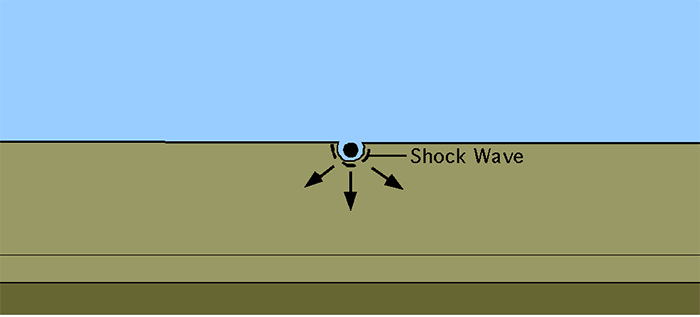The giant asteroid impact that caused a massive extinction event 65 million years ago also turned parts of the Earth's crust inside-out, providing scientists with a clue on how rock ripples under massive impacts – and insight into how early life might have started on Earth.
Researchers began drilling into the Chicxulub impact crater off the Mexican coast earlier this year, after waiting years to gain access, and these are the first results from below the crater.
After analysing the depths and compositions of rocks at the Chicxulub crater, scientists have found evidence for a new hypothesis of how peaks form in the centre of craters – which also hints at how early life might have been sheltered on our hostile planet.
Basically, the impact was so intense, it turned parts of the Earth's crust inside-out.
The team, made up of scientists from Imperial College London in the UK together with colleagues from across the world, says some rock layers may have been flipped across a distance of 30 kilometres (18.6 miles) in just a few minutes.
"It's absolutely crazy, but it tells us absolutely fundamentally how craters are formed," lead researcher Joanna Morgan told Rebecca Boyle at New Scientist.
The scientists used an oil rig-style offshore platform to retrieve samples from between 506 and 1,335 metres (1,660-4,380 feet) beneath the ocean floor, and uncovered ancient basement rock that wouldn't usually be so close to the surface.
 Animation showing how the Chicxulub crater formed. Credit: University of Arizona
Animation showing how the Chicxulub crater formed. Credit: University of Arizona
They then reconstructed a timeline of what might have happened, suggesting the impact lifted up rock from the bottom of the Earth's crust as far as 25 kilometres (15.5 miles) in just ten minutes.
A mountain range higher than the Himalayas lifted and sank again within the space of three minutes, creating a ring around the perimeter. In the centre of the crater, another burst of rock was flung skywards, just like liquid in a cup behaves when you drop something into it. This created a spike of basement rock which either flowed or collapsed into a structure geologists call a peak ring.
The problem is, geologists have never been sure which process was responsible for this peak ring – did cool rock crumble into a ring, or did hot rock ripple out?
The new results suggest that the crumbling of cooler rocks, rather than the complete melting and cooling of rocks, is the most likely hypothesis. In Chicxulub's case at least, the peak ring fell into its shape.
Not only did the researchers discover more about this incredible event, it also showed that peak ring rocks are more porous than was previously thought, so better able to let nutrient-rich water flow through them.
That means simple organisms could have started life inside these rocks, thanks to nutrients from the water and heat from the Earth's crust – not just at the Chicxulub site, but also at the many other asteroid impact sites from the planet's early history.
It's one way of explaining how life can begin and thrive deep inside rocks, something scientists still aren't sure about.
And there's yet another bonus for researchers thanks to the work at the Chicxulub crater: it gives us a template for investigating the crust composition of other planets.
If impact craters do shift and flip basement rocks as the new research suggests they do, then we can learn about the make-up of other planets from craters on their surface without having to drill deep into the crust.
Now the researchers want to carry out further analysis on their samples to try and figure out how these rocks could be moved around so much without actually melting, and how different forms of life could take hold.
"We are hoping that further analyses of the core samples will provide more insights into how life can exist in these subterranean environments," adds Morgan.
"It is hard to believe that the same forces that destroyed the dinosaurs may have also played a part, much earlier on in Earth's history, in providing the first refuges for early life on the planet."
The group's work has now been published in Science.
